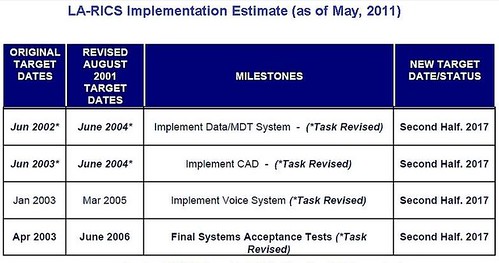 Los Angeles is building the largest public-safety broadband network in the U.S. thanks to a $154.6 million in federal grant from the NTIA.
Los Angeles is building the largest public-safety broadband network in the U.S. thanks to a $154.6 million in federal grant from the NTIA.
Scheduled to be completed next summer, the 231-site LA-RICS network will be overseen by FirstNet, the agency that coordinates the dedicated 700 MHz public safety network nationwide. FirstNet will begin building out its deployments in earnest in a year or two.
The Los Angeles Regional Interoperable Communications System Authority (LA-RICS) today approved a $175 million contract with Motorola Solutions to construct its public-safety LTE network.
The Los Angeles region will deploy a 700 MHz public safety mobile broadband network across all of Los Angeles County, with over 80 public safety agencies, 34,000 first-responders, and encompassing over 4,060 square miles and 10 million people. It will feature almost 300 wireless 700 MHz public safety broadband sites using new and existing infrastructure, fixed microwave backhaul rings , and 100-miles of high-capacity fiber backbone.
LA-RICS is one of only four entities that has signed a spectrum-lease agreement with FirstNet to use the 20 MHz of contiguous spectrum in the 700 MHz band that is licensed to FirstNet for public safety.
Congress earmarked $7 billion in federal funds to help develop a nationwide broadband network, called the First Responder Network Authority (FirstNet). The money is coming from proceeds from various FCC spectrum auctions, specifically the H Block, AWS, and 600 MHz auctions. FirstNet operations currently are funded by a $2 billion loan, but the remaining $5 billion is contingent upon FCC spectrum auctions generating enough revenue to fund the entire $7 billion, reports Urgentcomm, an industry news magazine.
Some observers believe the $7 billion is just the beginning. FirstNet will bill end users like Police and Fire for operational costs – which will likely be high.
FirstNet’s radios and service are likely to cost more than commercial LTE service since it must provide ubiquitous connectivity and the share the costs among fewer users. Those increased costs will likely be passed on to consumers.
Delays have set the schedule back at least two years.
Meanwhile, Release 12 of LTE, will include many features designed specifically to address public-safety needs such as push to talk with LTE Direct.
First responders successfully lobbied to get their own LTE spectrum. Now they have to build and run a nationwide LTE network on a $7 Billion budget.
It may be pure fantasy — or resemble a dystopian nightmare. AT&T and Verizon invested about $30 billion each in their LTE upgrades, notes Andrew Seybold — and they already had cell sites and infrastructure in place.
Related Dailywireless articles include; FirstNet: Get Utilities to Pay for It , FCC Orders 700 MHz Interoperability, SF Public Service Net: In Trouble?, Street light Provides Wi-Fi, Cell Coverage, Hotspot 2.0, Public Safety Spectrum Grab, Public Safety: Show Us The Money, Phoney Spectrum Scarcity, D-Block: It’s Done; Congress Pays, The 700MHz Network: Who Pays?, Big Bucks for 700 MHz Public Safety,
Posted on Fri, 07 Mar 2014 18:47:55 +0000 at http://www.dailywireless.org/2014/03/07/...r-network/
Comments: http://www.dailywireless.org/2014/03/07/.../#comments


